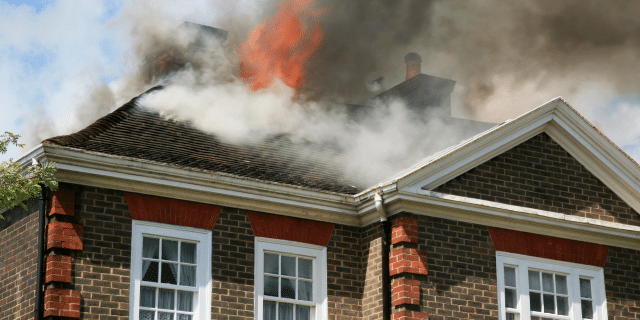It only takes a moment—a forgotten candle, an overloaded outlet, a stray spark from the stove—for a cozy home to turn into a dangerous blaze. Every year, thousands of families face the devastating aftermath of house fires, many of which could have been prevented. Understanding the most common causes of home fires isn’t just smart—it’s essential. Here’s what you need to know to keep your loved ones safe and your home protected.
Cooking
A leading cause of house fires, unattended cooking is one of the biggest risks in the kitchen. Cooking fires can ignite in seconds, and flammable items like towels or food packaging can easily catch fire if placed too close to a hot burner.
How to prevent:
- Stay in the kitchen. Never leave food unattended when frying, grilling, or broiling. If you must leave, turn off the stove or oven.
- Use timers. Set a timer as a reminder that something is cooking, especially for longer tasks like baking or simmering.
- Clear the area. Keep oven mitts, paper towels, curtains, and wooden utensils away from burners.
- Turn pot handles inward. Prevent accidents by keeping handles turned toward the back of the stove.
- Avoid distractions. Don’t cook if you’re feeling drowsy or have consumed alcohol or sedating medications.
Heating
As temperatures drop, heating equipment becomes a top source of home fires. Space heaters, fireplaces, and wood-burning stoves can all spark danger if not used carefully.
How to prevent:
- Keep a safe distance. Maintain at least 3 feet of space between heaters and anything flammable—furniture, curtains, bedding, etc.
- Upgrade old equipment. Choose space heaters that turn off automatically when overheated or tipped over.
- Maintain chimneys and furnaces. Have them professionally inspected and cleaned annually.
- Dispose of fireplace ashes properly. Let ashes cool completely and place them in a metal container with a lid. Place them outside and away from your home.
- Use fire screens. Always use a sturdy screen or glass door in front of fireplaces.
Electrical
Modern homes rely on more electronics than ever—but faulty wiring or improper use of power and extension cords can lead to disaster.
How to prevent:
- Don’t overload outlets. Avoid using multi-plug adapters or plugging too many devices into one outlet.
- Inspect cords. Replace frayed, cracked, or damaged cords immediately.
- Pay attention to wattage. Always use light bulbs that match the fixture’s recommended wattage.
- Look for warning signs. Flickering lights, discolored outlets, burning smells, or frequent blown fuses are red flags.
- Upgrade protection. Install Arc Fault Circuit Interrupters (AFCIs) and surge protectors. Consider smart sensors that alert you to abnormal power use or overheating.
- Call an electrician. Have a licensed professional inspect your system if you suspect any issues.
Candles
While they add ambiance, candles can also add risk. An open flame left unattended is a leading cause of home fires.
How to prevent:
- Never leave a candle burning unattended. Always extinguish it when you leave the room or go to sleep.
- Watch placement. Keep candles at least 12 inches away from anything flammable—curtains, books, decorations.
- Use sturdy holders. Place candles on heat-resistant surfaces and avoid wobbly furniture.
- Keep away from pets and children. Curious hands and wagging tails can easily knock over a candle.
- Don’t burn to the bottom. Leave at least a half inch of wax in the container to prevent overheating and cracking.
Dryer Vents
Dryers are a common cause of home fires, and too often, the lint traps are the culprit. Making sure your lint trap is not too full will help.
How to prevent:
- Clean the lint filter after every load. Remove lint from around the dryer rim.
- Check the vent hose regularly. Make sure it’s not kinked or clogged. Make sure the outdoor vent flap opens when the dryer is on.
- Move flammable items. Move cardboard and cleaning supplies away from the dryer, especially when it is on.
Smoking
Careless smoking is another major contributor to home fires—especially when done indoors or near flammable materials.
How to prevent:
- Never smoke in bed or when drowsy. It makes it too tempting to skip safe disposal and it’s too easy to fall asleep.
- Use deep, sturdy ashtrays. Ensure cigarette butts are completely extinguished.
- Don’t toss butts in the trash. Dispose of them in a metal container or douse with water before discarding.
General Fire Safety Tips
Preventing a fire doesn’t stop with avoiding hazards—it includes being prepared in case one does occur.
- Install smoke detectors. Place them on every level of your home, inside bedrooms, and outside sleeping areas. Test them monthly and change the batteries twice a year (when you change the clocks).
- Have an extinguisher on hand. Keep one in the kitchen and know how to use it. Check that it’s not expired.
- Keep flammable items out of reach. Store matches, lighters, and chemicals where children can’t access them.
- Follow these tips to fireproof your home. There’s a lot that you can do inside and outside.
- Create a fire escape plan. Practice it with your family so everyone knows how to exit quickly and safely.
Your home is one of your greatest investments. Make sure it is fully protected with the right insurance.
This article is furnished by California Casualty, providing auto and home insurance to educators, law enforcement officers, firefighters, and nurses. Get a quote at 1.866.704.8614 or www.calcas.com.
- You were probably raised by a nurse if… - November 30, 2025
- Stress Management Tips for Police Officers - November 26, 2025
- Helping Your Dog Lose Weight - November 21, 2025

